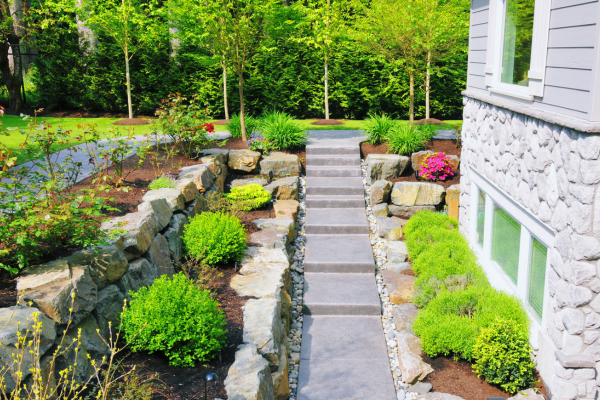Key Takeaways
- Landscape design trends of 2025 are not just about aesthetics but also focus on enhancing and respecting the natural environment.
- One of the significant trends is the increased use of native plants in landscaping. These plants require less maintenance, conserve water, and provide essential habitat for local fauna.
- Sustainability continues to be a major influence in landscape design due to the increasing effects of climate change. Practices like xeriscaping and using organic fertilizers are becoming more common.
- Color theory plays a significant role in landscape design in 2025. It is used to evoke emotions, create depth, and maintain balance in outdoor spaces.
- The top landscape design trends of 2025 emphasize sustainability, local flora, and the intelligent use of color, reflecting a growing awareness of our environmental impact.
- There’s a shift towards viewing outdoor spaces as extensions of the natural environment, to be nurtured and cared for, rather than areas to be ‘tamed’ or ‘controlled.’

As we transition into the year 2025, landscaping continues to evolve and progress, providing new and exciting trends that combine aesthetics, functionality, and sustainability for our outdoor spaces. Landscaping trends are no longer just about the visual appeal but are also focused on respecting and enhancing the natural environment. In this blog post, we will explore the top 10 landscape design trends of 2025 that are set to significantly influence our yards, gardens, and public spaces.
Embracing Native Plants
One of the most substantial trends emerging in 2025 is the increased use of native plants. These plants, which have naturally evolved to thrive in local conditions, require less maintenance and watering, and they provide essential habitat for local fauna. By using native plants, homeowners can create an ecosystem in their backyard, attracting birds, butterflies, and other beneficial wildlife. These plants not only enhance biodiversity, but they also create gardens that truly reflect the local landscape and cultural heritage. Native plants offer a sense of place and can help connect people with their local environment.
Sustainable Landscaping
As the effects of climate change become more apparent, sustainability continues to be a major influence in landscape design. Landscapers and garden owners are becoming increasingly aware of the need for water conservation, leading to the rise of xeriscaping. This method of landscaping involves the use of drought-resistant plants and efficient irrigation systems to reduce water usage.
Moreover, the use of eco-friendly practices is becoming more mainstream in 2025. Many garden owners are opting for organic, eco-friendly fertilizers over synthetic ones, reducing the amount of harmful chemicals entering the soil and waterways. Additionally, creating biodiverse gardens to attract a variety of wildlife species is also being practiced more widely. These practices contribute to a balanced and sustainable ecosystem, promoting a healthier environment.
Color Theory in Landscape Design
In 2025, color theory is playing a significant role in landscape design. Color is being used as a powerful tool to evoke emotions, create depth, and maintain balance in outdoor spaces. Landscapers are becoming more sophisticated in their use of color, leveraging complementary and analogous colors to create visually satisfying and harmonious gardens.
Understanding warm and cool color schemes, and how they can impact the perception of space and mood, is becoming an important part of garden design. By carefully choosing the color palette, landscapers can make a small garden appear larger, or a large garden feel more intimate, creating outdoor spaces that are not only beautiful but also emotionally resonant.
Conclusion
As we look forward to the top landscape design trends of 2025, it’s clear that there’s a strong emphasis on sustainability, local flora, and the intelligent use of color. These trends reflect a growing awareness of our environmental impact and a desire to create outdoor spaces that are not just visually pleasing but also beneficial to local ecosystems and biodiversity.
This shift towards sustainable and environmentally conscious landscaping represents a significant change in how we view our outdoor spaces. No longer are they just areas to be ‘tamed’ or ‘controlled.’ Instead, they are viewed as extensions of the natural environment, to be nurtured and cared for. It’s an exciting and transformative time to be involved in landscape design, and we are thrilled to see where these trends will lead us in the future.

Frequently Asked Questions
Q: What are the top landscape design trends of 2025? A: The top trends include the increased use of native plants, sustainable landscaping, and the use of color theory in landscape design.
Q: Why is the use of native plants a trend in 2025? A: Native plants, which have naturally evolved to thrive in local conditions, require less maintenance and watering. They also provide essential habitat for local fauna, enhancing biodiversity, and reflecting the local landscape and cultural heritage.
Q: What does sustainable landscaping involve? A: Sustainable landscaping involves practices like xeriscaping, which reduces water usage, and the use of organic, eco-friendly fertilizers, which reduce harmful chemicals entering the soil and waterways.
Q: How is color theory applied in landscape design? A: Color is used as a tool to evoke emotions, create depth, and maintain balance in outdoor spaces. Understanding warm and cool color schemes and how they can impact the perception of space and mood is an important part of garden design.
Q: What is the shift in how we view our outdoor spaces? A: There’s a shift towards viewing outdoor spaces as extensions of the natural environment to be nurtured and cared for, rather than areas to be ‘tamed’ or ‘controlled.’
